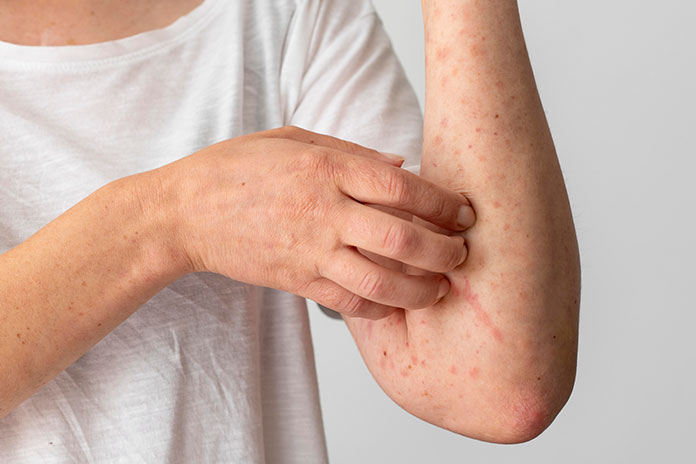Very often, dermatitis cannot be cured overnight. However, the means to relieve it exist after having been clearly identified by a medical diagnosis.
Table of Contents
How To Recognize Dermatitis? Definition
It is an inflammation of the superficial layers of the skin. She is not contagious. Its skin symptoms are pruritus, blistering, erythema (redness), oedema, and often oozing, crusting, and scaling. It is also accompanied by discomfort, nervousness or worry. The term dermatitis refers to different types of dermatitis, five of which are the most common.
The Main Types Of Dermatitis
Atopic Dermatitis Or Eczema
Atopic eczema, neurodermatitis, is the most common chronic skin condition. It is an allergic reaction of the skin, favored by a genetic ground conducive to allergies. Indeed, up to 70% of children with chronic eczema have a first-degree relative (father, mother, brother, or sister) who has had it themselves.
In this case, the individual secretes the same “IgE” antibodies as in the case of an allergy; these specific antibodies are created by mistake by the immune system in the presence of substances (pollen, animal hair, etc.). Furthermore, the skin is devoid of the hydrolipidic film, which naturally protects it, and allows allergenic molecules to cross it and come into contact with the skin’s immune defense cells.
The body’s response is the maladaptive inflammatory reaction that is eczema. It mainly affects young children aged 3 (infant eczema). It develops in flare-ups and then tends to subside in adolescence. In some cases, however, it may persist into the adult stage. In the adult stage, atopic dermatitis can take on a particular form, prurigo, which manifests as very itchy nodules all over the body.
Also Read: The Ultimate Guide To Skincare For Healthy, Glowing Skin
Contact Dermatitis
Unlike eczema, contact dermatitis is an inflammatory reaction with no hereditary origin. There are two types: irritative and allergic. More frequently, the irritant is caused by various substances (chemical products in the professional environment (construction trades, health professionals, hairdressers, horticulturists), detergents, solvents, and creams), while the allergic form is due to the presence of “IgE” antibody. Among the commonly allergenic substances is the nickel present in certain jewelry, the components of specific clothing (latex, etc.), cosmetics, perfumes, soaps and shampoos. The contact form is manifested by rashes such as pimples and blisters, burning, tingling, skin swelling, and redness.
Seborrheic Dermatitis
Neither hereditary nor allergic seborrheic dermatitis does not always have an obvious origin. It could be a reaction to stress or a hormonal or neurological disorder translation. Frequent in newborns in the form of milk crusts, in adults, it is manifested by crusts, dandruff, greasy and white or yellowish scales on the scalp, armpits and eyebrows, and even redness and hair loss.
Stasis Dermatitis
Also called varicose eczema, it is an inflammation generally of the skin of the lower limbs, linked to circulation problems such as venous hypertension. More widespread in women of a certain age, it manifests in pimples, eczema, and ulcers on the ankles and shins. It is often the symptom of venous insufficiency linked to heart failure. The treatment is topical and general, with compression and elevation of the legs.
Nummular Dermatitis
Also called nummular eczema, it is an allergic reaction often of hereditary origin. It is manifested by suppurative circular spots and scales, mainly on the outer face of the arms and legs and on the buttocks. It has been found that this form mainly affects middle-aged people. And among these are those already prone to hay fever or asthma.
How To Recognize Dermatitis?
There is a difference between a localized and transient rash, with dermatitis that deserves a dermatologist’s diagnosis for relief and treatment. Depending on our age and state of health, specific symptoms should alert us. This is the case with stasis, especially since the older adult is less alert to the significant signs of his general condition.
Redness, pruritus, oozing, blisters, scabs, swelling and thickening of the skin are all more or less developed symptoms. dermatitis in infants The atopic form in babies and young children obviously involves scrupulously following prescriptions and medical advice. In addition, it is essential not to add to the irritation of the baby’s skin, giving him only a daily shower with lukewarm water, resorting to dermatological bars without soap, and drying him without the rub but gently dabbing it.
Dress him in cotton clothes, which you will wash without chemical fabric softeners and rinse thoroughly. Apply a moisturizing cream to the skin to restore the skin’s barrier, especially in winter when the skin tends to dry out. On the other hand, during inflammatory flare-ups, do not apply cream to the affected areas.
How To Cure Dermatitis? Is It Possible?
Like any chronic inflammatory disease, there is no cure. But in 75% of cases, it returns to normal before age 10. If it persists in the adult stage, it relieves itself by regulating the immune response and fighting against inflammation, which makes it possible to space out attacks and reduce their intensity.
Dermatitis: Natural Treatments
Some plants are beneficial to the skin. Thus aloe vera, whose antibacterial and antimicrobial properties prevent infections from dehydrated skin and help heal skin lesions. Prefer aloe vera gel free of preservatives and alcohol (with a drying effect), and test it in small quantities on a local point of the skin.
In addition, vegetable oils moisturize the skin. This is the case with sunflower oil which moisturizes the skin and relieves inflammation and itching; virgin coconut oil is very effective on the skin of young children with eczema, or oil nigella, which prevents infections. It should be noted, however, that natural plant-based treatments are not exempt from diagnosis and essential medical treatment.
Also Read: Acne: Which Plants Internally?


